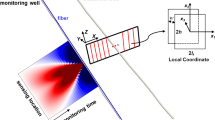Abstract
Ultrasonic studies have been used as low-cost, quickly updated, non-destructive techniques in geology and geo-technique. Conventional geophysical operations that allow measurements of wave velocity in rock mass are costly. In this study, we sought a strategy for calculation of wave velocity in rock mass without these field operations. The velocity of a wave in rock mass is a function of two major factors: the intact rock and joint properties. Wave velocity has the highest value in the intact rock, and decreases in the presence of joints, the poorer the conditions of the joints, the greater the decrease. Therefore, wave velocity can be predicted from a measurement of velocity in the intact rock and the properties of the joints. In this research, we first measured P-wave velocity in selected Andesite intact samples from the boreholes, and then measured the rate of effect of joint spacing, opening, orientation, infilling, and roughness on wave velocity by inducing joints in the rock. Afterwards, the orientations of the joints were recorded through surficial joint studies at 29 stations in field. Moreover, the characteristics of the underground joints (6,530 joints) were determined through geotechnical drillings along 9 boreholes (with a total length of 840 m). Finally, the velocity of the P-wave in the rock mass was calculated in field along the assumed profiles. For validation, we compared our velocity estimations with available field data along seven profiles with a total length of 644 m, coinciding with our assumed profiles. The calculated wave velocity and that measured through geophysical operation in field were in close agreement. Thus, wave velocity in rock mass could be computed at an approximation rate of about 10%.















Similar content being viewed by others
Data Availability
All the data, models, and codes generated or used during the study appear in the submitted article.
References
Altindag R (2012) Correlation between P-wave velocity and some mechanical properties for sedimentary rocks. J South Afr Inst Min Metall 112:229–237
Altindag R, Guney A (2005) Evaluation of the relationships between P-wave velocity (Vp) and joint density (J). In: The 19th international mining congress and fair of Turkey IMCET, Izmir, June 09–12, pp 101–106
Barton N (2007) Rock quality, seismic velocity, attenuation and anisotropy. Taylor & Francis/Balkema
Carvalho JP, Pinto C, Lisboa JV, Sardinha R, Catrapona A, Borges J, Tlemçani M (2010) Assessing the degree of fracturing and weathered layer thickness using seismic and GPR data. In: 72nd EAGE conference and exhibition incorporating SPE EUROPEC Barcelona, Spain
Del Rio LM, Lopez F, Esteban FJ, Tejado JJ, Mota M, Gonzàlez I, San Emeterio JL, Ramos A (2006) Ultrasonic characterization of granites obtained from Industrial quarries of extremadura (Spain). Ultrasonics 44:e1057–e1061. https://doi.org/10.1016/j.ultras.2006.05.098
El Azhari H, El Amrani El Hassani IZ (2013) Effect of the number and orientation of fractures on the P-wave velocity Diminution: Application on the building stones of the Rabat Area (Morocco). Geomaterials. https://doi.org/10.4236/gm.2013.33010
El Sayed AMA, El Sayed NA (2017) Impact of reservoir fluid saturation on seismic parameters: Endrod Gas Field. Earth Environ Sci 95:032028. https://doi.org/10.1088/1755-1315/95/3/032028
El Sayed AMA, El Sayed NA (2019) Calculation of cementation exponent and multiplier using P wave velocity and porosity for sandstone reservoirs. Earth Environ Sci 362:012001
Fathollahy M, Uromeiehy A, Riahi M A, Bashirgonbadi M (2015) Effect of joint opening on P-wave velocity measurement in Andesite rock samples. In: Seventh international conference on seismology and earthquake engineering, Tehran, Iran
Fathollahy M, Uromeiehy A, Riahi MA (2017) Evaluation of P-wave velocity in different joint spacing. Boll Geofis Teor Appl 58(3):157–168. https://doi.org/10.4430/bgta0208
Fehler M (1982) Interaction of seismic waves with a viscous liquid layer. Bull Seismol Soc Am 72(1):55–72
Hobbs B, Tchoketch Kebir M (2007) Non-destructive testing techniques for the forensic engineering investigation of reinforced concrete buildings. Forensic Sci Int 167:167–172
Kahraman S (2001) A correlation between P-wave velocity, number of joints and Schmidt hammer rebound number. Int J Rock Mech Min Sci 38(5):729–733. https://doi.org/10.1016/S1365-1609(01)00034-X
Kahraman S (2002) The effects of fracture roughness on P-wave velocity. Eng Geol 63(3–4):347–350. https://doi.org/10.1016/S0013-7952(01)00089-8
Kano S, Tsuchiya N (2002) Parallelepiped cooling joint and anisotropy of P-wave velocity in the Takidani granitoid, Japan Alps. J Volcanol Geoth Res 114:465–477
Khandelwal M, Ranjith PG (2010) Correlating index properties of rocks with P-wave measurements. J Appl Geophys 71(1):1–5. https://doi.org/10.1016/j.jappgeo.2010.01.007
Mohamed AK, Andreas W (2015) Study on P-wave and S-wave velocity in dry and wet sandstones of Tushka region. Egypt Egypt J Petrol 24:1–11
Sassa K, Watanabe T (1995) Velocity and amplitude of P-waves transmitted through fractured zones composed of multiple thin low-velocity layers. Int J Rock Mech Min Sci Geomech Abstr 32(4):313–324. https://doi.org/10.1016/0148-9062(95)00008-5
Schoenberg M (1980) Elastic wave behavior across linear slip interfaces. J Acoust Soc Am 68(5):1516–1521. https://doi.org/10.1121/1.385077
Sheraz AM, Emad MZ, Shahzad M, Arshad SM (2014) Relation between uniaxial compressive strength, point load index and sonic wave velocity for Dolorite. Pak J Sci 66(1):60–66
Trtnik G, KavcˇicˇF TG (2009) Prediction of concrete strength using ultrasonic pulse velocity and artificial neural networks. Ultrasonics 49:53–60
Yagiz S (2011) P-wave velocity test for assessment of geotechnical properties of some rock materials. Bull Mater Sci 34:947–953
Yasar E, Erdogan Y (2004) Correlating sound velocity with the density, compressive strength and Young’s modulus of carbonate rocks. Int J Rock Mech Min Sci 41:871–875
Acknowledgements
The authors would like to acknowledge the collaboration made by Iran Water and Power Resources Development Company, Sad Tunnel Pars Company, and the Institute of Geophysics of Tehran University.
Author information
Authors and Affiliations
Corresponding author
Additional information
Publisher's Note
Springer Nature remains neutral with regard to jurisdictional claims in published maps and institutional affiliations.
Rights and permissions
About this article
Cite this article
Fathollahy, M., Uromeiehy, A., Riahi, M.A. et al. P-Wave Velocity Calculation (PVC) in Rock Mass Without Geophysical-Seismic Field Measurements. Rock Mech Rock Eng 54, 1223–1237 (2021). https://doi.org/10.1007/s00603-020-02326-6
Received:
Accepted:
Published:
Issue Date:
DOI: https://doi.org/10.1007/s00603-020-02326-6




